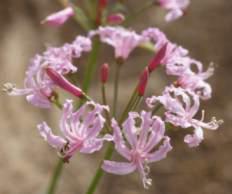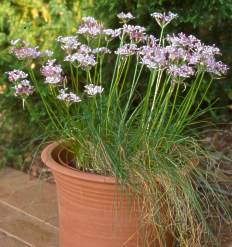Nerine masoniorum
Nerine masoniorum L.Bolus
Family: Amaryllidaceae
Common names: Masons' nerine, Transkei lily
Introduction
A bulbous plant with a profusion of pink flowers, Nerine masoniorum is ideally suited to cultivation in pots and window-boxes.

Description
Description
Nerine masoniorum has dainty, compact flowerheads which appear in late summer in the Southern Hemisphere (February-March), and last for about three weeks. It has extremely narrow, grass-like leaves.
It is ideally grown as a container subject, but is also useful in the rock garden or as an edging plant along a path. It is evergreen when cultivated in temperate climates.
Conservation Status
Status
Rare and Endangered.
Distribution and habitat
Distribution description
Nerine masoniorum has an extremely limited distribution and is an endangered species, only known from one locality in the former Transkei (now part of Eastern Cape), where it is threatened by encroaching informal settlements and cattle grazing.

In the wild, N. masoniorum is completely deciduous due to the very cold winters. The flowers are strongly self fertile and the ripe seeds drop to the ground as soon as they are dislodged from the capsules, forming dense colonies.
Derivation of name and historical aspects
History
The plant owes its name to Marianne Mason, who first collected material near Umtata in the eastern Cape in the late 1920s, and her brother.
The genus Nerine was established in 1820 by the cleric and amaryllid expert, Rev. William Herbert. He named it after Nerine, a guardian sea nymph sent by the Roman goddess Venus to rescue Vasco da Gama's armada en route to India. Nerine is a genus of about 25 species, endemic to southern Africa. The most well-known species in the horticultural trade are the scarlet forms of N. sarniensis, the Guernsey lily, which is indigenous to the southwestern parts of Western Cape, and N. bowdenii, the hardy, 'large pink nerine', from the high Drakensberg of KwaZulu-Natal and the midlands of Eastern Cape.
Uses
Use
Nerine masoniorum is not known to be used medicinally by the indigenous peoples of Eastern Cape.
Growing Nerine masoniorum
Grow
Nerine masoniorum is the most easily cultivated of all the dwarf nerines and requires a free-draining medium such as equal parts of river sand, loam, and finely sifted compost. The bulbs should be planted with the top of the neck just above soil level, and once planted should be left undisturbed for at least four years, as best flowering results are always obtained from well-established plants. The plants prefer full sun. They will also flower well in light shade, but under the latter conditions the flower stems lack the strength of sun-grown specimens, and tend to fall over.

N. masoniorum makes an excellent container subject and is also a most valuable bedding plant where it is suited to planting as a thick border to larger annuals and perennials such as Senecio elegans and Lobelia valida.
Plants require regular watering during the summer months (a good soaking once per week if natural precipitation is lacking). They can be dried off completely in winter but do not object to winter rainfall, provided the soil medium has excellent drainage.
Propagation is easy and is either by separation of offsets (daughter bulbs) from the mother bulb, or by seed. Separation is best carried out in early spring just as warmer weather sets in and new leaves begin to develop. Carefully lift thick clumps with a large garden fork, shake off excess soil, and then separate daughter bulbs by carefully tugging them away from the mother bulb. Do not forcibly break the bulbs away as this will damage the bulbs' basal plate. Daughter bulbs that do not come away easily by careful tugging are not yet ready for separation. Prevent the perennial, fleshy roots from drying out by replanting separated daughter bulbs as soon as possible, at a distance of 2-3 cm apart.
Seeds are produced in profusion in March in the Southern Hemisphere. They are fleshy and water-rich, and do not undergo a dormant period, but germinate almost immediately they become ripe. Sow the seeds in seed trays as soon as they are easily detached from the dry flower capsules, evenly sprinkling them over the surface, and covering with 5 mm of sowing medium. Seed trays are best placed in semi-shade until seedlings are growing strongly, after which they can gradually be moved to full sun. Germination is rapid and the young plant rapidly forms a bulb that will reach flowering stage in two to three years, under ideal conditions.
The main pest affecting N. masoniorum is the lily borer, also known as the amaryllis caterpillar (Brithys crinii). The night-flying moth lays its eggs on developing flowerbuds and along flower stems, especially during the hot summer months. The voracious caterpillars rapidly bore into the tissue and can cause collapse of flowerstems in as little as two to three days. In highly susceptible areas in parts of Gauteng, KwaZulu-Natal and Western Cape, this pest can be treated preventatively by spraying with carbaryl every two weeks. Poor drainage of the growing medium leads to fungal rotting of the bulb roots which affects flowering performance, but seldom causes death of the bulb.
References
- Duncan, G.D. 2002. Grow nerines: Kirstenbosch Gardening Series. National Botanical Institute, Cape Town.
- Hilton-Taylor, C. 1996. Red Data List of Southern African Plants. National Botanical Institute, Pretoria
- Victor, J.E. 2002. South Africa. In: J.S. Golding (ed), Southern African plant Red Data Lists. Southern African Botanical Diversity Network Report 14 (pp. 93-120), SABONET, Pretoria.
Credits
Graham Duncan
Kirstenbosch National Botanical Garden
February 2003
Plant Attributes:
Plant Type: Bulb
SA Distribution: Eastern Cape
Soil type: Sandy
Flowering season: Autumn
PH: Acid
Flower colour: Pink
Aspect: Full Sun, Morning Sun (Semi Shade)
Gardening skill: Easy
Special Features:
Horticultural zones










Rate this article
Article well written and informative
Rate this plant
Is this an interesting plant?
Login to add your Comment
Back to topNot registered yet? Click here to register.